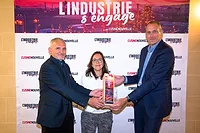In-Mold Coating Breakthrough Cuts VOCs and CO₂ in Automotive Manufacturing

Image courtesy of Nippon Paint.
Nippon Paint Automotive Coatings Co., Ltd. (NPAC) and Uchihamakasei Corp. have jointly developed Japan’s first in-mold coating (IMC) technology for large thermoplastic automotive exterior applications. The technology combines resin molding and surface coating into a single integrated process, streamlining production and reducing environmental impact.
After resin is molded inside the tool, paint is injected directly into the mold, forming a uniform coating film on the component’s surface. This process eliminates the need for traditional coating booths and post-coating drying ovens. According to estimates by Uchihamakasei, this technology reduces CO₂ emissions by approximately 60% and enables zero volatile organic compound (VOC) emissions.
The coating system uses solvent-free paint developed by NPAC. The formulation emits less than 4 g/L of VOCs and delivers a VOC emission reduction of over 99% compared to conventional coatings. Performance is maintained at the level of traditional automotive finishes.
The in-mold coating process also enables superior design expression. Coating surfaces formed through mold transcription exhibit improved smoothness and reproducibility compared to spray coating. Fine patterns, geometric embossing, and nano-level texture replication—including iridescent structural color effects—are possible, allowing for more complex and high-quality surface finishes.
To develop the system, the project team optimized the resins and catalysts while refining the coating formulations in conjunction with the in-mold process. The result is a next-generation solution that blends precision surface design with more efficient and sustainable production.
NPAC and Uchihamakasei plan to offer the technology to automotive OEMs with the goal of eventual mass production.
About In-Mold Coating Technology
Background
As the automotive industry advances toward sustainability goals, manufacturers are seeking new ways to reduce emissions and improve production efficiency. In response, NPAC and Uchihamakasei collaborated to create an alternative coating method designed to support both environmental and performance goals.
After several years of development, the teams have established a process suitable for the mass production of large thermoplastic automotive components.
Key Features
1. Process Integration and Efficiency
In the IMC method, paint is injected directly into the mold during the molding process. Unlike spray coating, which typically achieves about 70% efficiency, the IMC process ensures near 100% paint utilization. The coating is cured inside the mold in less than one minute, eliminating the need for separate drying ovens and significantly reducing energy use.
FIGURE 1 | In-mold coating process.
 Image courtesy of Nippon Paint.
Image courtesy of Nippon Paint. 2. Low-VOC, Solvent-Free Coatings
NPAC’s coating formulation emits less than 4 g/L of VOCs, helping reduce workplace exposure and lowering the environmental footprint. The coatings also meet durability and aesthetic standards required for exterior automotive parts.
FIGURE 2 | Comparison of processes with conventional coating.
 Image courtesy of Nippon Paint.
Image courtesy of Nippon Paint. FIGURE 3 | Comparison of exterior appearance quality under fluorescent lighting.
 Image courtesy of Nippon Paint.
Image courtesy of Nippon Paint. 3. High-Precision Design Transfer
Because the coating is applied within the mold, it allows for fine control over surface design. Features such as complex microtextures, structural coloration, and detailed embossing are easily replicated—capabilities that are difficult or impossible to achieve with spray methods.
FIGURE 4 | Various design transcriptions using specialized molds.
 Image courtesy of Nippon Paint.
Image courtesy of Nippon Paint. NPAC and Uchihamakasei will continue to promote the adoption of this technology to help reduce the environmental impact of automotive manufacturing.
Read the original article here.
Looking for a reprint of this article?
From high-res PDFs to custom plaques, order your copy today!







